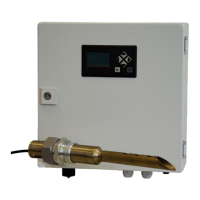33
6 Commissioning
6.3.3 Response of the Internal Resistance Regulation
The internal ceramic resistance between the reference and O
2
electrodes (R
ki
O
2
) is a func-
tion of the sensor temperature, which is constantly regulated for a perfect function
of the probe.
NOTICE
The optimum operating point of the KS1D probe lies at a R
ki
O
2
of about 20
This value must be reached before the first offset calibration or after a probe replacement is
triggered.
If the measured R
ki
O
2
deviates too strongly from the optimum setpoint value R
ki
S = 20
(see Menu 213), the installation situation of the probe must be changed for optimum operation:
R
ki
O
2
> 25
• The probe does not become hot enough:
– The probe was installed in a cold spot and is thus cooled.
Determine a new installation site.
– If necessary, check whether aR
ki
O
2
of 20 is reached when it is disassembled.
If a too high R
ki
O
2
is assumed by the internal resistance regulation, the probe func-
tions outside of its optimum operating point.
R
ki
O
2
< 20
• The internal resistance regulation automatically sets the R
ki
setpoint value to 20:
- After 30 minutes in fault-free measurement operation and subsequent offset
calibration
- After 120 minutes in fault-free measurement operation without an offset calibration

